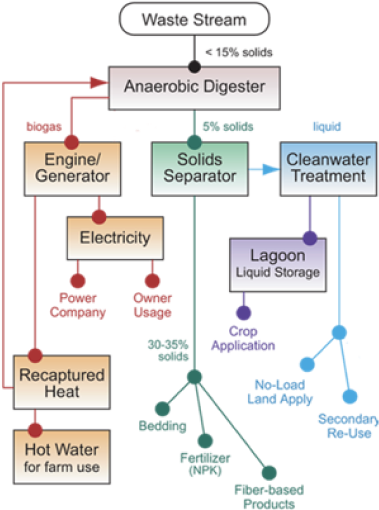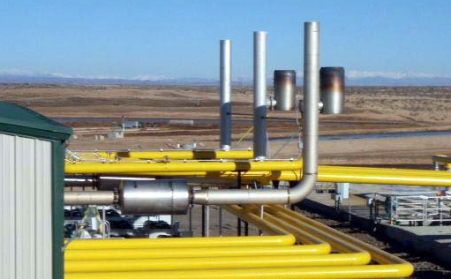
POULTRY LITTER DIGESTION
A DVO digester offers the unique ability to digest poultry manure on a belt-collection system where no bedding material is utilized. Our system:
- Works without outside waste material additions.
- Operates with little or no fresh water – egg wash water is sufficient.
- Utilizes scrubbed and recycled effluent liquid from the digester for dilution of the influent waste stream.
- Produces an economical, beneficial and stable nitrogen fertilizer from the odorous ammonia that is normally volatilized into the atmosphere.
- Significantly reduces odor from the poultry facility and its waste.
Example Project
A DVO system in operation at a 1.2-million-layer family farm in Ohio digests poultry litter, feathers, mortalities, and egg wash water.

Poultry Flow-Chart
The DVO poultry system is an efficient, continuous, low-maintenance system that requires minimal labor. It resolves issues surrounding poultry digestion and is an asset to the waste management of poultry facilities.

NOTE: DVO may provide some, but not all, components depicted on this chart.
Ready to Talk?TESTIMONIALS
I can't imagine dairying without a digester. We feel it's really good for our public relations, our environment. We would never do any dairying without a DVO digester. Even if the electricity and manure solids sales made it only break even, the other benefits the system brings to a dairy would still make the digester essential.
– Joe Bonlender, Clover Hill Dairy, Fond du Lac, WisconsinAdditional Resources
Lorem ipsum dolor sit amet, consectetur adip isicing elit. Sed ut perspiciatis, unde iste natus error sit voluptatem accus antium doloremque laudantium, totam rem aperiam eaque ipsa, quae ab illo.
Related Frequently Asked Questions
How do I get started?
With only a few basic pieces of information, namely:
- What is being processed (data such as TS, TSS, pH are helpful too)
- Daily volumes (max)
- Timeframe (when desired)
We can estimate both the capital and operating costs. Melissa VanOrnum, 920-418-4543, will be glad to help you investigate at no obligation.
Who can I contact for more information?
Contact Melissa VanOrnum, DVO Vice President Marketing, at 920-849-9797 or info@DVOinc.com
Is your “Guaranteed Retention Time” also one reason why DVO digesters produce more biogas using the same feedstocks, than other designs?
Yes. And also why we see better odor reduction and pathogen control.
Why do DVO digesters see a much better pathogen reduction than the “complete-mix” or “plug-flow” designs?
3rd party figures are publicly available (see above-referenced "EPA - Gordondale" report available on our website) where others typically do not. For pathogens that cause farmers problems such as E-coli and salmonella, we see a 97-99% removal. Often lab reports come back "none detected." This is only possible because our design offers a guaranteed hydraulic retention time (HRT) -- which means every unit of waste that goes into our digester is retained and processed for a guaranteed number of days. In a complete-mix digester this is impossible. Some waste leaves the system too soon (waste not fully digested will contain many more pathogens, and energy not harvested), and some is also left in and processed longer than necessary, which reduces system efficiency. And, you can't kill the same pathogen more than once.
Can I add additional energy substrates to my digester? Such as food wastes?
Absolutely. DVO's unique 2-stage "Mixed Plug-Flow™" design actually does a more thorough job of processing food wastes and other energy substrates, compared to complete-mix/CSTR and other digesters. This is partly due to our guaranteed retention time. — namely, waste does not leave the system "too soon". For this reason DVO also does a better job of pathogen and odor destruction. However, before adding any substrate for the first time we recommend a lab analysis be performed on a sample to ensure that there are no bactericides, high salt concentrations, etc. that might disrupt the digestion process.
Will the digester take in ALL my biowastes?
Yes. They are designed to accept a wide variety of organic wastes, with a range of solids content.
What does it cost to install?
The installation cost is relative to the volume of waste to be processed daily. The particular characteristics of any waste stream can also influence system design and cost as well. Some upfront testing is usually desired.
Is PR easy to operate?
Yes. Like our digester, Phosphorus Recovery is designed to operate automatically and with minimal supervision.
Do I need a DVO digester? Or will any digester do?
As digester designs differ, so can their performance. Partly because a DVO digester's unique design offers a "guaranteed retention time," waste streams are more thoroughly processed than with other AD designs. The benefit is both a higher level of Phos removal and more economical operation.
DVO is initially rolling Phosphorus Recovery out to its customers, but may also offer this process to other AD owners at a later date (TBD).
Do I need a digester for this to work?
Yes. Waste streams that are anaerobically processed first enable us to concentrate and remove phosphorus economically.
Can this process be applied to co-digested, mixed-waste streams?
Yes. For example, phosphorus recovered from urban organics can be diverted from landfills. The PR system can accommodate a high-degree of input variability.
How do I know yours is a good design when everyone else claims theirs is “the best available?”
- Don't take our word for it. The U.S. EPA keeps track of U.S. farm digester installations: https://www.epa.gov/agstar/livestock-anaerobic-digester-database Download this Excel spreadsheet, sort it by the "System Designer" column, and you will see how many DVO has sold in the previous few years (versus competing systems). You will also see repeat DVO customers – a key indicator of customer satisfaction.
- Talk directly to our customers. Any of them. Unlike others we don't provide a "referral sheet." Our customers are our best salespeople, and we encourage you to ask them about their experience with our system. For example, in the dairy industry some of the largest and most respected names (such as Fair Oaks, Bos, and Bettencourt) and operations of all sizes and configurations (scrape, flush, vac, sand etc.), employ our system.
- Compare actual performance figures. It's hard to find complete and accurate performance figures from other companies, especially for manure waste streams that do not contain any substrates (conveniently making valid apple-to-apple comparisons impossible). The EPA commissioned an extensive study at one of our sites, our first built – and the results are available here.
Why do DVO’s biosolids have the reputation of being an excellent bedding material for animals?
Our guaranteed hydraulic retention time means all waste is uniformly processed, and none leaves the vessel too soon. In a Complete-Mix/CSTR digester, some waste leaves too soon, leaving food for bacteria, odor and pathogens. Some also remains longer than desired, decreasing processing efficiency.
Why do DVO digesters see much better pathogen reduction than “complete-mix” or “plug-flow” designs?
Third-party figures are publicly available, where others typically do not. For pathogens that cause farmers problems, such as E. coli and salmonella, we see 97-99% removal. Lab reports often come back "none detected." This is only possible because our design offers a guaranteed hydraulic retention time, which means every unit of waste that goes into our digester is retained and processed for a guaranteed number of days. In a complete-mix digester this is impossible. Some waste leaves the system too soon, and waste not fully digested will contain many more pathogens, and energy not harvested. Some waste also is left in and processed longer than necessary, which reduces system efficiency.
What do I do with the liquid from the digester?
Since the digester changes the nutrients and waste from primarily organic to primarily inorganic, you can apply digested liquid directly to a growing crop without fear of burning the leaves or killing the plant. As a result, our farmers typically hold their digested liquid for use during the growing season to increase their crop yield (often, significantly). Optionally, DVO can treat the digestate, concentrate the nutrients, and recycle the digestate to dampen incoming, drier wastes. This process is necessary to economically digest poultry litter.
What happens to the nutrients in the manure/biowaste?
No nutrients are lost because the digester only breaks down carbon-based molecules. It cannot break down nitrogen, potassium or phosphorous. However, it does change the form of the nutrients, from an organic state to an inorganic state, which means nutrients are more "plant-accessible." This is why liquid coming from a digester can be applied to a growing crop without burning the leaves. In fact, the nutrients act as an excellent starter fertilizer.
As my operation expands, can my digester expand with it?
Yes. There are two ways to expand your digester. One is to lengthen the digester like you might lengthen a barn. The other option is to build a second digester next to the first and have the two share a common wall.
How much does it cost?
The cost will vary considerably depending on the size and layout of the operation. We can provide a rough estimate after gaining an understanding of certain aspects of your operation. We work hard to keep our system costs down without impacting system performance or reliability.
What are your digester’s products/revenue streams?
Biogas, which can be used to create electricity or in a boiler to create steam. Or it can be scrubbed to create natural gas. Other revenue streams include a solid, a liquid and waste heat.
- Digested solids can be used as a high-quality animal bedding, replacing other bedding sources such as sand or sawdust. Solids can also be sold as a peat-moss replacement or a fertilizer.
- The digested liquid effluent can be applied to a growing crop, reducing the likelihood of runoff and increasing crop yield.
- Other revenue streams include the possible sale of carbon credits, renewable energy credits, and the Federal Production Tax Credit.
- Waste heat in the form of hot water is a byproduct that digester owners are using to heat various parts of their operation (parlor, maintenance shop, etc.)
How large must my waste stream be to make economic sense?
A common question that receives the common response, “It depends.” The major determining factors are how much energy is available in the waste stream, and what electrical rates are available from your utility. There are other factors as well. Our digesters are scalable and accommodate a wide range of waste volumes. For example, our dairy farm customers range in size from 600 cows to over 10,000 head (and multiples for larger dairies).
Can broiler litter also be digested?
Yes. Barn top-scrape / cleanout intervals and bedding material selection can optimize digester performance.
How do I know what can be digested?
At no cost or obligation DVO will examine your waste stream(s) content or lab data and provide any recommendations.

One-of-a-kind Technology
Our patented Two-Stage Linear Vortex™ digesters process more farm and industrial wastes globally than any other company or design. The digester design ensures that manure and biowaste are completely mixed and processed for the same amount of time and temperature. This maximizes biogas production and ensures that any byproducts can be used immediately, without the need for further processing.
Learn More